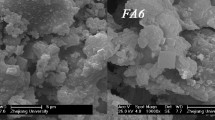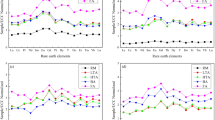Abstract
The bromine (Br) and iodine (I) in raw coal, bottom ash (BA) and fly ash (FA) from seven thermal power plants (TPP) digested with pyrohydrolysis were determined by using inductively coupled plasma mass spectrometry (ICP-MS). The distribution behavior of Br and I during coal combustion were researched and the environmental effects of Br and I in BA, FA and gas phase were analyzed. The results show that both elements Br and I in combustion products from TPP are usually present in decreasing order of the distribution rate as gas phase, FA and BA. In FA and BA, the distribution rate of Br (8.11% and 1.68%, respectively) are generally lower than that of I (9.26% and 4.67%, respectively); on the contrary, in gas phase, the former (90.2%) is higher than the latter (86.9%). In addition, for gas phase, the percentage of Br2 (2.0%–75%) in total Br is generally larger than that of I2 (1.0%–10%) in total I. The environmental effects for Br and I emitted into atmosphere from TPP may be larger than those remained and captured by both FA and BA.
Similar content being viewed by others
References
Aiuppa A, Federico C, Franco A, Giudice G, Gurrieri S, Inguaggiato S, Liuzzo M, Mcgonigle A J S, Valenza M, 2005. Emission of bromine and iodine from Mount Etna volcano. Geochem Geophys Geosyst, doi: 10.1029/2005GC000965.
Alicke B, Hebestreit K, Stutz J, Platt U, 1999. Iodine oxide in the marine boundary layer. Nature, 397: 572–573.
Amiro B D, Sheppard S C, Johnston F L, Evenden W G, Harris D R, 1996. Burning radionuclide question: What happens to iodine, cesium and chlorine in biomass fires? Science of the Total Environment, 187(2): 93–103.
Bowen H J M, 1979. Environment chemistry of the elements. Lodon: Academic Press.
Fuge R, Johnson C C, 1986. The geochemistry of iodine - A review. Environmental Geochemistry Health, 8: 31–54.
Hou X L, Feng X Q, Li C S, Ding W J, Qiang Q F, Chai Z F, 1998. Study on the recovery of iodine after acid digestion and ashing of biological samples using 131I tracer and neutron activation analysis. Journal of Nuclear and Radiochemistry, 20(4): 242–246.
Huang W H, Tang X Y, 2002. Mobility and concentration of trace elements during coal combustion. Coal Geology of China, 14(Supp.): 75–87.
Liu L Z, Wu D S, Li P, 2010. Iodine emission during the soil baking process and its environmental significance. Earth and Environment, 38(4): 439–443.
Meij R, Winkel T H, 2007. The emissions of heavy metals and persistent organic pollutants from modern coal-fired power stations. Atmospheric Environment, 41: 9262–9272.
Nelson P F, Shah P, Strezov V, Halliburton B, Carras J N, 2010. Environmental impacts of coal combustion: A risk approach to assessment of emissions. Fuel, 89: 810–816.
Peng B X, Wu D S, 2012. Modes of iodine occurrence in bituminous coal and anthracite and their environmental effects. Journal of Fuel Chemistry and Technology, 40(3): 257–262.
Peng B X, Wu D S, Li P, 2011. Study on modes of occurrence of bromine in coals using sequential chemical extraction procedure. Environmental Science, 32(7): 2109–2113.
Ratafia-Brown J A, 1994. Overview of trace elements partitioning in flames and furnaces of utility coal-fired boilers. Fuel Processing Technology, 39(2): 139–157.
Song D Y, Qin Y, Zhang J Y, Wang W F, Zhen C G, 2005. Distribution of environmentally-sensitive trace elements of coal in combustion. Coal Conversion, 28(2): 56–60.
Sun J X, Jervis R E, 1986. Trace elements in coal and their distribution during combustion. Science in China (series A), 12: 1287–1294.
Tang Q, Liu G, Yan Z, Sun R, 2012. Distribution and fate of environmentally sensitive elements (arsenic, mercury, stibium and selenium) in coal-fired power plants at Huainan, Anhui, China. Fuel, 95: 334–339.
Tang X Y, Huang W H, 2004. Trace elements in Chinese coal. Beijing: Commercial Press, 91.
Vassilev S V, Eskenazy G M, Vassilev C G, 2000a. Contents, modes of occurrence and origin of chlorine and bromine in coal. Fuel, 79: 903–921.
Vassilev S V, Eskenazy G M, Vassileva C G, 2000b. Contents, modes of occurrence and behavior of chlorine and bromine in combustion wastes from coal-fired power stations. Fuel, 79: 923–937.
Wang W F, Qin Y, Song D Y, 2003. Study on the mobility and release of trace elements in coal-fired power plant. Actascientiae Circumstantiae, 23(6): 748–752.
Wang Y Q, Meng H T, Xue H B, 1995. Distribution and emissions of trace elements in coal combustion process. Coal Mine Environmental Protection, 9(6): 25–28.
Wen M Z, Xu W D, 2010. Mobility and release of hazardous trace elements in coal-fired power plant. Journal of China Coal Society, 35(9): 1518–1523.
Wu D, Deng H, Wang W, Xiao H, 2007. Catalytic spectrophotometric determination of iodine in coal by pyrohydrolysis decomposition. Analytica Chimica Acta, 60: 83–88.
Wu D, Deng H, Zheng B, Wang W, Xiao H, 2008. Iodine in Chinese coals and its geochemistry during coalification. Applied Geochemistry, 23: 2082–2090.
Yang S J, Qian Q F, Jiang Z, Wang C, Yuan J W, 1983. Elements distribution of various products during combustion in coal-fired power plant. Environmental Chemistry, 2(2): 32–38.
Author information
Authors and Affiliations
Corresponding author
Additional information
Supported by the National Natural Science Foundation of China (40133010, 40973080)
Rights and permissions
About this article
Cite this article
Peng, BX., Li, L. & Wu, DS. Distribution of bromine and iodine in thermal power plant. J Coal Sci Eng China 19, 387–391 (2013). https://doi.org/10.1007/s12404-013-0320-3
Accepted:
Published:
Issue Date:
DOI: https://doi.org/10.1007/s12404-013-0320-3




